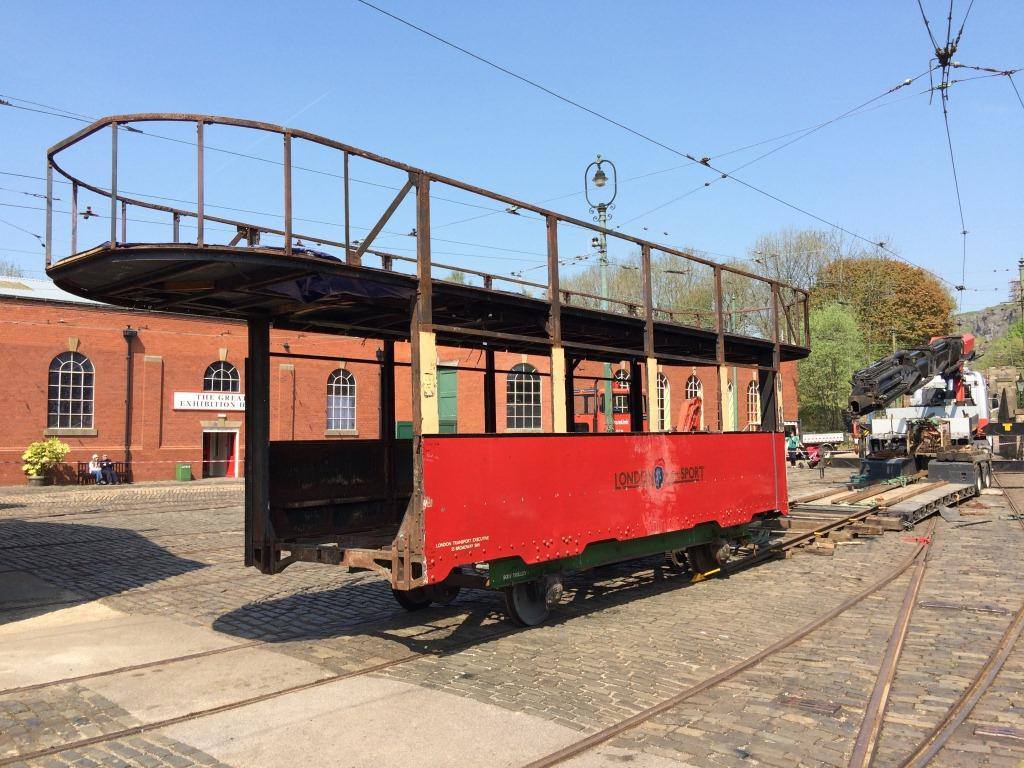The heavily stripped body shell of London County Council 1, alias ‘Bluebird’, left Crich on Thursday 12th May for a short road journey to Ilkeston. There, specialist engineers are to undertake expert repairs on the framework to remove the accumulated corrosion and ensure that it will be fit for many more years of service as restoration of this unique tramcar gets underway.
Garmendale Engineering Limited have been commissioned to carry out the work on the body frame, which unusually combines metal with wood, presenting some unusual challenges. The same firm will also work on the body side panels before the car is returned to Crich for reconstruction to continue. The tram is already separated into several parts, with the main body frame being the section that left by lorry on 12th May; this was recently reduced in stature by the removal of its roof, and furthermore since with the end platforms being cut off. The roof and part of the upper deck structure remains on site mounted on a platform placed on accomodation trucks, and both bogies are also present at the museum where extensive refurbishment will be carried out. Much of the interior was carefully removed and placed in storage containers; what will happen to this material is unclear but some key components are expected to be used in a future display on the tram, due to the fact that it influenced the design of many other vehicles, and also acknowledging that it has survived in largely original condition for so long.
Interestingly, this is the first time that LCC 1 has ever left the museum (well some of it anyway!) as it has been on static display there since arriving from the closed Clapham Transport Museum in the 1970s. It has not been stated how long it will be away for, but its temporary absence should at least offer some breathing space in the workshop which has been rather full with many parts of this one tram taking up a large amount of room. Also in the works, Glasgow 22 remains under attention with its much-delayed overhaul still ongoing a year after it started, whilst Blackpool 40 occupies the Paint & Wash Bay whilst being fully repainted. Hopefully both of these useful trams will be back in use soon, allowing attention to shift towards other cars in need of attention, such as Chesterfield 7 which should receive paintwork touching-up once the work on 40 is completed.

A very odd looking LCC 1 is seen in the depot yard at Crich being shunted into position ready to be loaded up for a short road trip taking it away from the museum for the first time since it joined the fleet four decades ago.

The peculiar sight of LCC 1 - such as it is currently - on a low loader, leaving the museum en route for Ilkeston.(Photos courtesy of the Crich Tramway Village Facebook page)

Not to mention Sheffield 74 (mouldy roof) and Blackpool 630 (air brakes?) both requiring workshop time as well before they appear in service again. Maybe one of these will find their way into the workshop now some space has been cleared?
Good to see progress with this vehicle. One point – why is LCC 1 always called ‘Bluebird’ when MET 331 is never called by its original nickname ‘Cissie’? All those London prototypes of the period had nicknames – the other two, long since scrapped, being ‘Poppy’ and ‘Bluebell’.
331 does sometimes get referred to as ‘Cissie’ but the origin of the nickname is more obscure than that of ‘Bluebird’ for LCC1. The relevance of the latter will be obvious when the restored tram emerges from Crich workshops looking as it did when leaving Charlton in 1932.
Yes – the restoration of famous blue livery will be a delight to see, but also ‘Bluebird’ was a more popular name at the time, originally coming from Maeterlinck’s successful play “The Blue Bird of Happiness”, and adopted as the name of a number of speed-record-breaking cars belonging to Sir Malcolm Campbell (and later his son, Donald). Often such names come from popular plays or films of the period, another being ‘Green Goddess’ of Liverpool.
Up north ‘Cissie’ was a common name for sister so perhaps there was a pair.